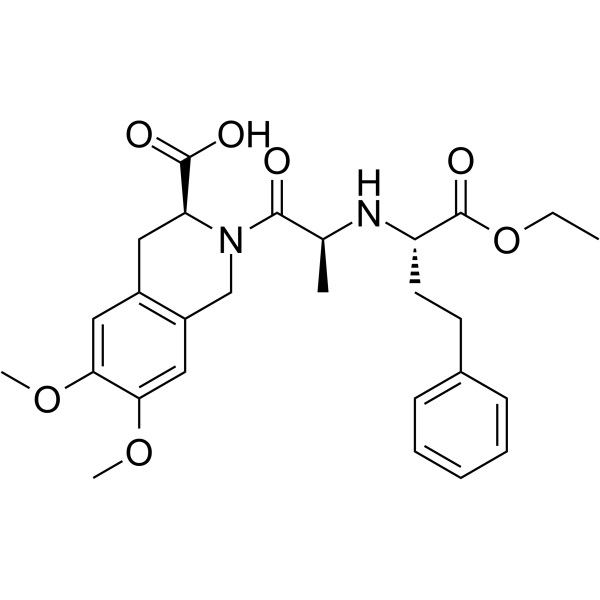Moexipril
Modify Date: 2025-08-25 22:47:14

Moexipril structure
|
Common Name | Moexipril | ||
|---|---|---|---|---|
| CAS Number | 103775-10-6 | Molecular Weight | 498.57 | |
| Density | 1.2±0.1 g/cm3 | Boiling Point | 709.3±60.0 °C at 760 mmHg | |
| Molecular Formula | C27H34N2O7 | Melting Point | N/A | |
| MSDS | N/A | Flash Point | 382.8±32.9 °C | |
Use of MoexiprilMoexipril is an orally active and potent angiotensin-converting enzyme (ACE) inhibitor. Moexipril can readily penetrate lipid membranes and thus target plasma and tissue ACE. Moexipril may improve endothelial dysfunction and exert neuroprotective effects. Moexipril can used for cardiovascular disease research[1][2]. |
| Name | (3S)-2-[(2S)-2-[[(2S)-1-ethoxy-1-oxo-4-phenylbutan-2-yl]amino]propanoyl]-6,7-dimethoxy-3,4-dihydro-1H-isoquinoline-3-carboxylic acid |
|---|---|
| Synonym | More Synonyms |
| Description | Moexipril is an orally active and potent angiotensin-converting enzyme (ACE) inhibitor. Moexipril can readily penetrate lipid membranes and thus target plasma and tissue ACE. Moexipril may improve endothelial dysfunction and exert neuroprotective effects. Moexipril can used for cardiovascular disease research[1][2]. |
|---|---|
| Related Catalog | |
| Target |
IC50: 2.1 nM (purified ACE from rabbit lung), 1.75 nM (ACE in rat plasma)[1] |
| In Vitro | Moexipril shows inhibitory activity against purified ACE from rabbit lung and ACE in rat plasma, with IC50 values of 2.1 nM and 1.75 nM, respectively[1]. Moexipril (0-100 μM, 24 h) significantly reduced the percentage of damaged neurons in a dose-dependent manner[3]. Moexipril (0-100 μM, 24 h) significantly attenuates Fe2+/3+-induced neurotoxicity[3]. Moexipril dose not cause significant changes in the percentage of apoptotic neurons[3]. |
| In Vivo | Moexipril (SHR, 10 mg/kg, Orally, once a day for 3 days) completely blocks plasma ACE activity 1 h after dosage and still inhibits 56% plasma ACE activity 24 h afterward[1]. Moexipril (SHR, 0-30 mg/kg, Orally, once a day for 4 weeks) dose-dependently decreases arterial blood pressure, and inhibits plasma and tissue ACE activity[1]. Moexipril (NMRI mice, 0.3 mg/kg, IP, once) significantly reduces the infarct area on the mouse brain surface[3]. Moexipril (Long-Evans rats, 0.1 mg/kg, IP, once) significantly attenuates the cortical infarct volume[3]. Animal Model: SHR (spontaneously hypertensive rats, n=10)[1] Dosage: 10 mg/kg Administration: Orally, once daily for 3 days Result: Completely blocked plasma ACE activity 1 h after dosage and still inhibited 56% plasma ACE activity 24 h afterward, decreased the concentration of ANG Ⅱ and increased the concentration of ANG Ⅰ 1 h after dosage and recovered to control levels 24 h after dosage. Animal Model: SHR (n = 8 to 10 per group)[1] Dosage: 0, 0.1, 1, 3, 10, 30 mg/kg Administration: Orally, once daily for 4 weeks Result: Decreased arterial blood pressure, and inhibited plasma and tissue (lung, aorta, heart and kidney) ACE activity in a dose-dependent manner. Animal Model: NMRI mice (male, Permanent focal ischemia)[3] Dosage: 0, 0.03, 0.3, and 3 mg/kg Administration: IP, once (injected 1 h before middle cerebral artery occlusion) Result: Significantly reduced the infarct area on the mouse brain surface (at 0.3 mg/kg), and other doses were not effective. Animal Model: Long-Evans rats (male, Permanent focal ischemia)[3] Dosage: 0, 0.01, 0.1 mg/kg Administration: IP, once (injected 1 h before middle cerebral artery occlusion) Result: Significantly attenuated the cortical infarct volume from 114.4 to 98.2 mm3 as compared to non-treated animals (at 0.01 mg/kg), did not reduce the infarct volume of the rat brain at dosages higher than 0.01 mg/kg. |
| References |
| Density | 1.2±0.1 g/cm3 |
|---|---|
| Boiling Point | 709.3±60.0 °C at 760 mmHg |
| Molecular Formula | C27H34N2O7 |
| Molecular Weight | 498.57 |
| Flash Point | 382.8±32.9 °C |
| Exact Mass | 498.236603 |
| PSA | 114.40000 |
| LogP | 4.05 |
| Vapour Pressure | 0.0±2.4 mmHg at 25°C |
| Index of Refraction | 1.565 |
| InChIKey | UWWDHYUMIORJTA-HSQYWUDLSA-N |
| SMILES | CCOC(=O)C(CCc1ccccc1)NC(C)C(=O)N1Cc2cc(OC)c(OC)cc2CC1C(=O)O |
| Moexiprilum |
| (3S)-2-(N-{(1S)-1-[(ethyloxy)carbonyl]-3-phenylpropyl}-L-alanyl)-6,7-bis(methyloxy)-1,2,3,4-tetrahydroisoquinoline-3-carboxylic acid |
| Univasc |
| [3S-[2[R*(R*)],3R*]]-2-[2-[[1-(Ethoxycarbonyl)-3-phenylpropyl]amino]-1-oxopropyl]-1,2,3,4-tetrahydro-6,7-dimethoxy-3-isoquinolinecarboxylic Acid |
| (3S)-2-((2S)-N-((1S)-1-Carboxy-3-phenylpropyl)alanyl)-1,2,3,4-tetrahydro-6,7-dimethoxy-3-isoquinolinecarboxylic acid 2-ethyl ester |
| 3-Isoquinolinecarboxylic acid, 2-[(2S)-2-[[(1S)-1-(ethoxycarbonyl)-3-phenylpropyl]amino]-1-oxopropyl]-1,2,3,4-tetrahydro-6,7-dimethoxy-, (3S)- |
| UNII-WT87C52TJZ |
| Moexipril |
| Moexipril (INN) |
| Moexipril [INN:BAN] |
| Moexiprilum [INN-Latin] |
| (3S)-2-{N-[(1S)-1-(ethoxycarbonyl)-3-phenylpropyl]-L-alanyl}-6,7-dimethoxy-1,2,3,4-tetrahydroisoquinoline-3-carboxylic acid |
| (3S)-2-{N-[(2S)-1-Ethoxy-1-oxo-4-phenyl-2-butanyl]-L-alanyl}-6,7-dimethoxy-1,2,3,4-tetrahydro-3-isoquinolinecarboxylic acid |
| (3S)-2-{N-[(2S)-1-Ethoxy-1-oxo-4-phenylbutan-2-yl]-L-alanyl}-6,7-dimethoxy-1,2,3,4-tetrahydroisoquinoline-3-carboxylic acid |
| MFCD00865878 |
| Uniretic |